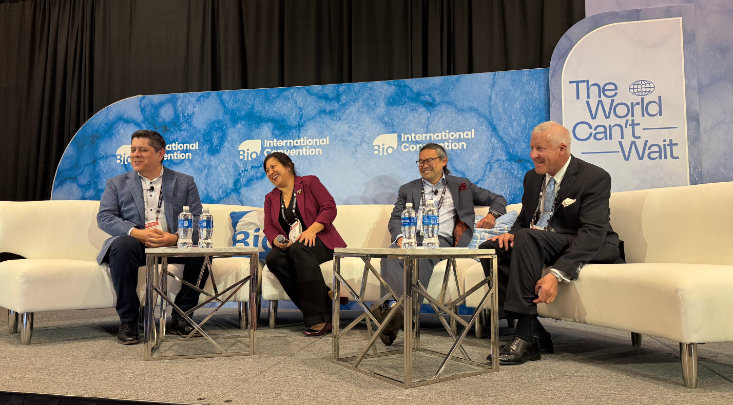Discussing the future of biotech: Innovation, sustainability, and growth in a dynamic landscape

With biotech facing both extraordinary potential and persistent pressure, a panel of experienced leaders gathered in a breakout session at BIO 2025 to explore how the industry is evolving—and what might come next. Moderated by Ben Castro, Vice President and General Manager, Large Molecule at Thermo Fisher Scientific, the session brought together:
- Parika Petaipimol, Vice President of Technical Operations, Upstream Bio
- Brian Tham, Principal Consultant, Peregrine Bio, LLC
- Stephen Grant, Industry Executive/Fractional COO and Angel Investor
Together, they offered a candid, often pragmatic view of the innovations shaping the field, the operational realities behind them, and the cultural shifts redefining what progress looks like.
Highlights from BIO International 2025 Thermo Fisher Scientific Panel Discussion
What technology and innovations get adopted in the biotech and biopharma industry, and why?
Despite rapid technological advancements, the panel emphasized that adoption in biotech isn’t driven by novelty—it’s driven by utility. The innovations that gain traction are those that simplify processes, reduce burden, and deliver clear operational or patient-centered value.
That theme emerged clearly in discussion of past innovations that succeeded not because they were groundbreaking in theory, but because they addressed pain points in practice. The adoption of single-use technologies, for example, was less about disrupting manufacturing norms and more about eliminating time-consuming, risk-prone steps like cleaning validation and column packing.
“If someone can find a way to get you out of a task you hate—for a price—you’ll pay it,” said Tham, reflecting on the success of single-use technologies and why AI may follow a similar path—if it delivers practical wins.
Still, panelists acknowledged that while new technologies have improved efficiency and optionality, they haven’t fully translated into lower costs or dramatically increased throughput. These realities, they noted, highlight the need for broader innovation strategies that address not only scientific complexity but also economic feasibility and operational scalability.
Sustainability in Biomanufacturing: Intention vs. action
That grounded view extended to discussions around sustainability. While public commitments and Environmental, Social, and Governance (ESG) reporting are becoming more common, implementation still lags behind ambition. Panelists pointed out that sustainability is often deprioritized in the face of more immediate pressures, such as speed, cost, and compliance—but there are signs of change.
At Upstream Bio, sustainability is being integrated into both product development and partner selection. “We’ve extended dosing frequencies—that reduces waste,” said Petaipimol. “And we look at what our partners are doing too. It has to be a shared responsibility.”
Panelists noted that more companies are embedding sustainability into operational KPIs—tracking things like carbon footprint, distribution costs, and reuse of water, solvents, and materials. Even so, cultural and regulatory barriers remain. “Sustainability often ends up being a tiebreaker,” said Tham, “not a driver.”
That tension between intent and implementation is especially visible in biomanufacturing, where decisions about stainless steel versus single-use systems carry complex environmental tradeoffs. (For a deeper understanding of how these choices affect resource use and operational priorities, read our white paper, Sustainable systems: Evaluating the environmental impact of single-use biomanufacturing technology.)
AI in Biotechnology: More promise than practice—for now
Artificial intelligence, too, is caught in this space between promise and practicality. While AI is accelerating early discovery and molecule screening, its use in manufacturing and quality operations remains limited.
Part of the challenge is cultural: scientists are hesitant to let go of hard-earned processes, and organizations are cautious about handing decisions over to algorithms. But the potential is clear, particularly in areas like knowledge management, where AI could help unlock buried institutional expertise.
“We’re in this interesting moment where we don’t trust the black box, but we don’t have time to train the human,” said Grant.
Regulatory and ethical considerations also loom large, from concerns around bias and data quality to the need for transparency in AI-generated decisions. Panelists suggested that the next generation of biotech professionals will be key to unlocking AI’s full potential if they can combine digital fluency with foundational scientific understanding.
Fear, funding, and the pressure to de-risk
That need for early clarity is becoming even more important in today’s funding environment. Investors are increasingly focused on risk mitigation, prioritizing assets with validated targets and clear pathways. Programs that can’t demonstrate de-risked strategies early on may struggle to attract support—regardless of potential. “Investors are driven by greed and fear,” Tham said. “And right now, fear is winning.”
The panel observed a shift toward more cautious investment, especially in the U.S., with growing interest in safe, proven indications. In contrast, European investors may be more proactive in sourcing new opportunities. Either way, startups and emerging biotechs are pushing the field forward, often developing creative “at-risk” development strategies that help them secure future funding.
Flexibility as a strategic advantage
This shift is prompting companies to seek more adaptive development models that support early-stage biotech with infrastructure and insight, while still being robust enough to serve the needs of large pharma.
Success increasingly depends on partners that can scale and flex in step with the science—offering not just technical capabilities, but also the operational and financial flexibility to help programs advance despite resource constraints.(For early-stage innovators in particular, financing solutions like equipment leasing and technology refresh programs can help extend limited budgets while keeping pace with evolving needs.)
New generation, new expectations
Ultimately, the panel agreed that one of the biggest forces shaping the future of biotech may not be a technology at all—but a generational shift. Today’s emerging workforce brings a new lens to the field: one that’s deeply tech-fluent, values-driven, and less interested in hierarchy or traditional career paths.
“They already have the ability,” Petaipimol said. “What’s going to matter most is what motivates them and how we adapt to that.”
This workforce may also be better equipped to integrate tools like AI and ML, and more attuned to sustainability values, thereby further accelerating industry change.
The path forward
In biotech, progress has always come from those who are willing to challenge the status quo. But as the panelists made clear, transformation isn’t just about what’s possible—it’s about what’s prioritized. And in an industry that thrives on both precision and purpose, the future will belong to those who can deliver both.
Explore our fully integrated CDMO and CRO capabilities for faster biologics development. Watch the webinar.


